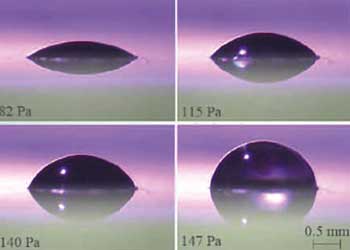Lens has potential applications in camera phones.
Hank Hogan
Mobile phones may eventually take better pictures, thanks to a team from the Institute of Materials Research and Engineering in Singapore. The group demonstrated a variable-focus lens by using pressure to shape a liquid interface. The technique could be employed in compact optical systems for focusing and zoom.
Isabel Rodriguez, an institute research scientist and project team member, noted that biconvex, biconcave, planoconcave and planoconvex lenses of different sizes can be created with the approach. Lens tuning is done solely through pressure changes and does not require electricity, which is not the case in alternative methods. Finally, Rodriguez said, lenses 10 µm and smaller can be fabricated.

As the pressure increases from 82 to 147 Pa, a bubble of water forms and grows in a 2-mm-diameter well, creating a planoconvex lens. The focal length and other optical properties vary with the curvature of the bubble. Courtesy of the Institute of Materials Research and Engineering.
To do so, the researchers exploit capillary forces. In a demonstration of the technique, they fabricated wells ranging from 100 µm to 3 mm in diameter in polymethyl methacrylate (PMMA) substrates and constructed a channel within the substrate to the wells. They filled the wells with water through the channel and used the same channel to apply pressure.
When under no pressure, the liquid formed a concave surface and lens. As the pressure rose, so, too, did the liquid. The bubble thus created formed a lens, with the height controlled solely by pressure.
For a biconvex lens, they drilled the wells through the PMMA, and the pressure-induced bubble formed equally on both sides. For a planoconvex lens, they placed a 0.2-mm glass cover over one side of the substrate so that the liquid bulged out only on the other side when they increased the pressure.
Their measurements indicate that the focal length of a planoconvex lens created using a 2-mm well could be tuned to a practical minimum of 2.9 mm. The maximum focal length they measured was 7.5 mm, a figure set by measuring instrumentation and not by the lens.

Fluid lenses could be used in applications that require small focusing and zoom mechanisms. Here, a camera phone takes a picture at a distance of 15 mm without (left) and with (right) an adjustable liquid lens.
The method has some limitations. For instance, the lenses with the largest diameters have an upper curvature limit due to gravity- and vibration-induced distortions. The researchers can overcome this by using a liquid/liquid interface rather than a liquid/air one. For the liquid/liquid lens, they immersed a glass capillary in low-viscosity silicon oil.
However, institute research scientist and project leader Saman Dharmatilleke noted that a liquid/liquid lens would be harder to implement in a miniaturized optical system, which is where he foresees applications for the technology.
“We are now building liquid lens modules for mobile camera applications,” he said.